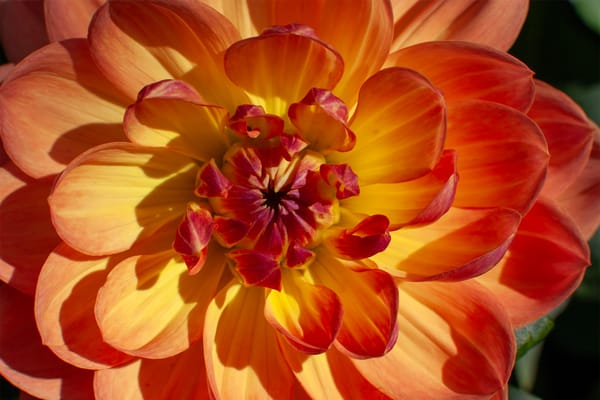Turning Garden Beds into Discovery Zones
There’s magic in planting a flower and watching it grow—and dahlias, with their vivid colors and endless variety, are a perfect way to spark a child’s curiosity. Whether in a school garden, community plot, or backyard, dahlias offer a playful gateway into science, nature, and creative exploration. Here’s how to turn your dahlia beds into vibrant, hands-on learning spaces, with projects designed to engage young gardeners and budding scientists.
Creating a Children’s Dahlia Garden
1. The Kids’ Plot — A Garden They Can Call Their Own
Dedicate a section of the garden—or even a few large tubs—as a “children’s dahlia patch.” Let young gardeners pick their own varieties, focusing on compact, single-flowered dahlias like the Happy Single series or Roxy. These blooms not only brighten a space but invite pollinators, turning every visit to the plot into a real-time nature lesson.
Activity Idea: Before planting, have children sketch their border design with colored pencils. Planning color themes, plant heights, and even naming each plant gives them a sense of ownership and creative control.
2. The Rainbow Bed — Growing a Living Spectrum
Encourage children to grow a rainbow of dahlias—one color for each arch of the rainbow. Label each with plant tags and set up a weekly “growth watch” where kids measure stem height and count blooms.
Creative Follow-Up: Let children photograph or draw each flower as it opens. They can make a rainbow collage or a decorative sign for their plot showcasing their living color wheel.
3. The Sensory Garden — Touch, See, Smell
Choose dahlias with different petal shapes (ruffled, spiky, flat), varied heights, and soft or rough foliage textures. Add fragrant companions like lavender or mint to create a garden that delights all the senses.
Sensory Challenge: Encourage kids to describe each plant using their five senses—or create a scavenger hunt for different textures, colors, and scents.
Simple Dahlia Experiments for Young Gardeners
| Experiment | Aim | What to Observe |
|---|
| Sunlight & Growth | Grow one plant in full sun, one in partial shade. | Which grows taller? Which flowers more? |
| Watering Needs | Water one daily, another every three days (don’t let wilt). | How do they differ in size, leaves, or flower count? |
| Pollinator Watch | Count bee and butterfly visits for a week. | Which flowers attract the most? Create a visitor tally chart. |
| Color & Temperature | Grow dark and light flowers in the same spot. | Do darker colors fade faster in sun? |
| Petal Patterns & Maths | Count petals on different dahlias. | Spot number patterns, symmetry—are petals multiples of certain numbers? |
Why it Works: These simple experiments turn observation into discovery. They teach children to ask questions, make predictions, and see plants as living experiments in their own backyard lab.
School & Classroom Dahlia Activities
1. See-Through Growing — Watching Roots & Shoots
Plant tubers in clear-sided pots or jars filled with compost. Children can watch as roots anchor and shoots push upward. Pair with magnifiers for up-close observations.
2. DIY Cuttings — The Magic of Plant Propagation
With supervision, children can take basal cuttings and track how new plants root and grow. Have them document progress in a “Roots Diary,” sketching or photographing changes week by week.
3. Dahlia Journals — A Season of Discovery
Each child keeps a journal to record planting dates, weather patterns, first shoots, flowering times, and pollinators seen. Encourage sketches, pressed petals, or photographs alongside notes.
Creative & Cross-Curricular Projects
- Plant & Paint: Have children paint or draw their favorite bloom, exploring color blending, texture, and symmetry.
- Seed vs. Tuber Challenge: Grow dahlias from both seeds and tubers—compare the results. Which grows faster? Flowers sooner?
- Dahlia Dissection: Carefully open a bloom to examine petals, pollen, and stamens—introducing basic plant anatomy with hands-on learning.
- Garden Maths: Measure stem heights, count leaves or blooms, and graph results to bring numbers alive in a natural context.
Tips for Successful Child-Led Projects
- Use peat-free compost and encourage organic, wildlife-friendly practices.
- Let children name their plants and take charge of care routines—watering, deadheading, mulching.
- Blend science, maths, and art in activities for richer, multi-disciplinary learning.
- Celebrate their achievements with a “Dahlia Discovery Day”—invite families to view the gardens, journals, and artwork.
Why It Matters — Growing More Than Just Flowers
When children grow dahlias, they’re not just nurturing plants—they’re cultivating responsibility, observation skills, and a lifelong connection to nature. These simple projects transform school gardens and home plots into spaces of wonder, where every leaf unfurling or bee visiting becomes part of a story they helped grow.











